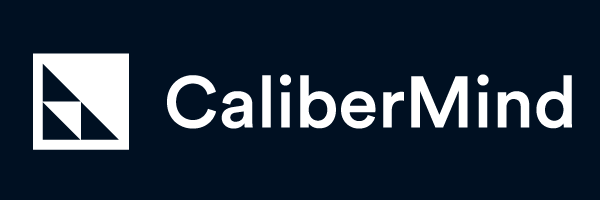Table of Contents
Insights - Attribution Overview Dashboard 2.0
The Attribution Overview Dashboard 2.0 Integrates the functionality of all the legacy dashboards and filters into one interactive view. With a few clicks, filters, KPI tiles, bar charts, and tables can be used to visualize all kinds of Big Data metrics and trends. An easily digestible "data story" is presented in this business intelligence dashboard.
Where is the Attribution Overview Dashboard 2.0 Menu?
The Attribution Overview Dashboard 2.0 is located on the left menu rail within the Attribution 2.0 folder.
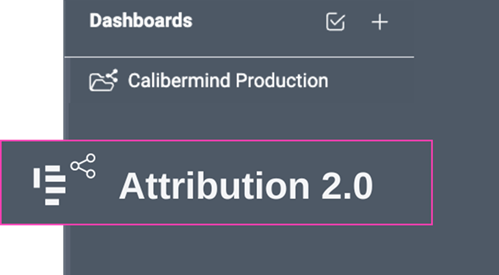
Where are my Legacy Menus?
The Attribution Legacy Menus are located on the left menu rail within the Legacy Attribution folder.
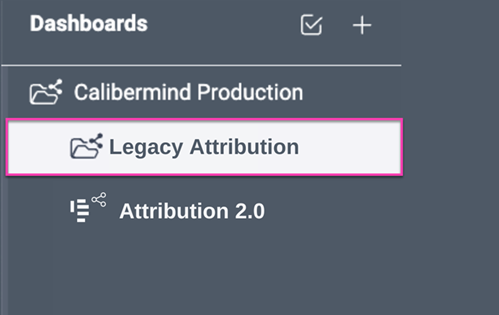
Attribution Overview Dashboard 2.0 Elements
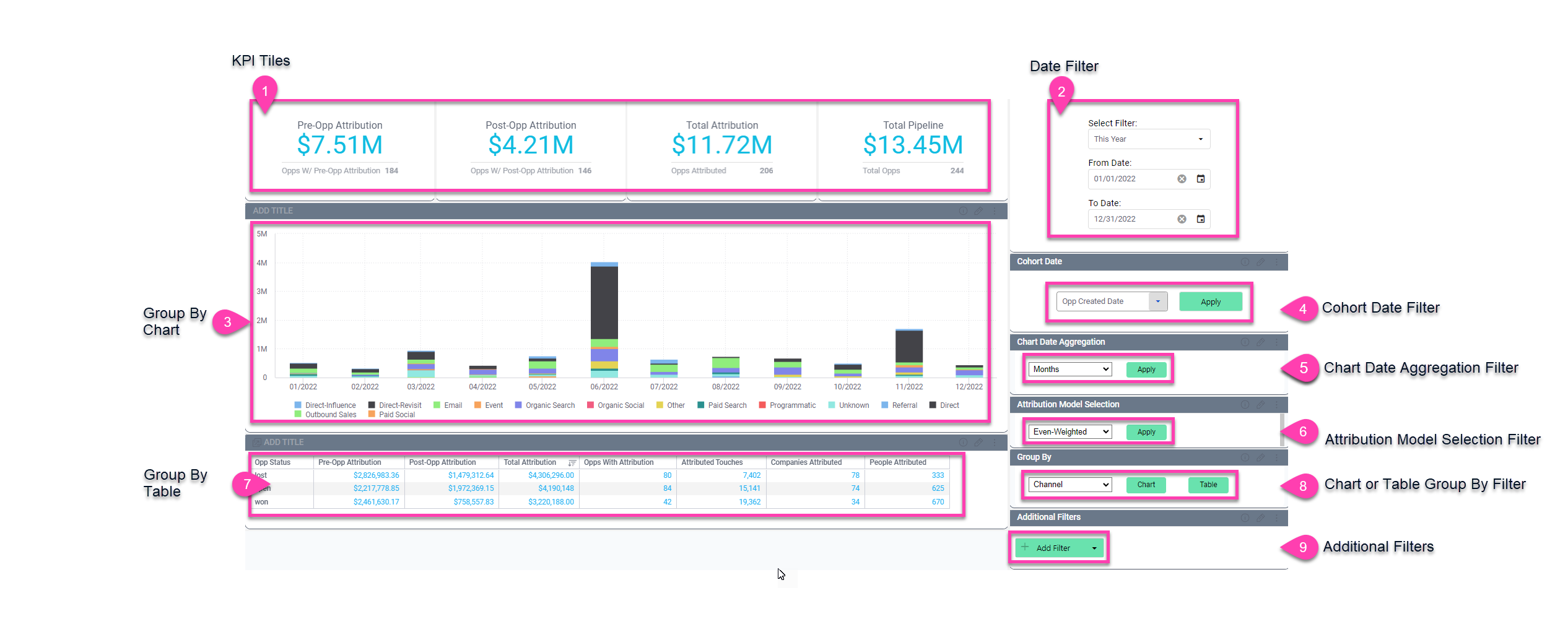
|
|
|
|
|---|---|---|
| Top Level KPI Tiles | Pre-op attribution, Post-op attribution, Total attribution. Total pipeline. Below each KPI is a sub metric of the count of ops. |
|
| Date Filter | The date filter allows the user to select a specified time period or ad hoc dates. The Date Filter updates both the Group By Chart and Group By Table simultaneously | |
| Group by Chart | The Group By Chart reflects selections made from the Cohort Date Filter (4); Chart Date Aggregation Filter (5); Attribution Model Selection Filter (6); Group By Table (7); Chart or table Group By Filter (8); and Additional Filters (9). It is important to note that the Group By Chart is independant of the Group By Table within this dashboard. To refresh and view data by using the Chart button on the Chart or Table Group By Filter below. The Group By Chart is NOT linked to the Group By Table - these elements function independently of each other. |
|
| Cohort Date Filter | The selections available on the Cohort Date Filter dropdown list are Opp Created Date, Opp Close Date, and Touch Date. The Cohort Date Filter automatically updates the Group By Chart (3) when selected. To refresh the Group By Table (7) you will need to click the green Table button on Chart or Table Group By Filter (8) below. | |
| Chart Date Aggregation Filter | Selections available on the Chart Date Aggregation Filter are Weeks, Months, Quarters, Years. This dropdown list will reflect changes on the Group By Chart (3). | |
| Attribution Model Selection Filter | Select an option on the Attribution Model Selection Filter to determine how much attribution credit is distributed across Groups. Choices include Chain-Based, Even-Weighted, First Touch, Middle Touch, and W-Shaped. Data will be displayed in the Group By Chart (3) or Group By Table (7). | |
| Group By Table | The Group By Table is an interactive widget that allows you to update and view data based upon filter selections available in the Chart or Table Group By Filter dropdown list (8). Once you have made a selection click the green Table button to refresh the data within the Group By Table. To refresh the filter values of Attribution Model Selection (6) in the Group By Table click the green Table button located on the Chart or Table Group By Filter (8). The Group By Table is NOT linked to the Group By Chart - these elements function independently of each other. |
|
| Chart or Table Group By Filter | The Chart or Table Group By Filter dropdown list offers the following selections. Campaign, Campaign Type, Channel, Companies, Industry, Department, Job Level, Program, and Opp Status. Once you have made a selection you click either/both the green Chart | Table button to refresh the data within the Chart or Table. The Group By Table AND the Group By Chart are not linked - these elements function independently of each other. |
|
| Additional Filters | The Additional Filters provides granular drill down capabilities. First select the preferred top categories, then select the cooresponding subcategories |

New Attribution Dashboard 2.0 Features for 2023
Attribution Cohort Date Dropdown list
Includes: Opp Created Date, Opp Close Date, Touch Date
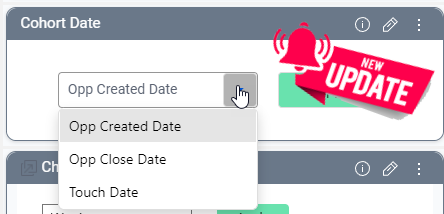
Chart Date Aggregation
Includes: Weeks, Months, Quarters, Years
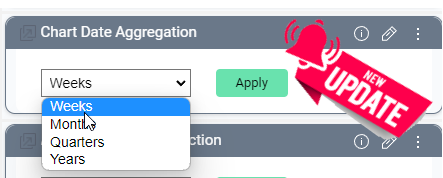
Attribution Model
Includes: Chain-Based, Even Weighted, First Touch, Middle Touch, W-Shaped
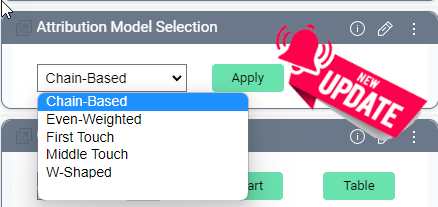
Group By
Includes: Campaign, Campaign Type, Channel, Companies, Industry, Department, Job Level, Program, Opp Status
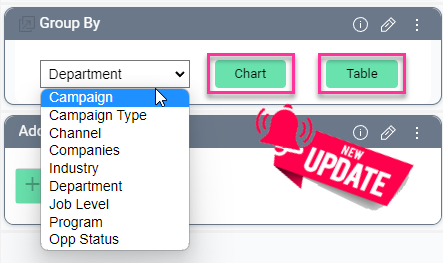
Use Case Video 1: Which Campaigns Perform Best When?
How can I tell which campaigns are good at lead generation?
Lead generation or name acquisition is best represented by the First-Touch model. The first-touch model (by default) looks up to 365 days before opportunity creation and assigns 100% of the "credit" to that first recorded interaction.
First-Touch attribution will be different than what you see in your CRM for two reasons:
- We are not looking at the first touch associated with the primary contact like your CRM does - we look at all people (leads and contacts) that we can match back to the account. Even anonymous touches where we don't know the person but do know the account (intent signals are a perfect example because intent data providers normally keep the person's information anonymous and only elevate which account they are with.
- We are looking at the first touch within 365 days before the opportunity was created (this can be customized), and depending on your marketing automation integration settings, you may either be looking at the very first touch associated with the primary contact or the most recent touch if automation is overwriting that Lead Source value.
Here is a video that shows exactly how we select the model and drill down to campaign specifics to understand what and how people are first interacting with your brand:
How can I tell which campaigns are good at initial demand generation?
Meeting generation or qualified lead conversions are best represented by the single-touch model, Middle Touch. This model assigns 100% of the "credit" or dollar value of an opportunity to the touch closest to opportunity creation.
Middle-Touch attribution will be different than what you see in your CRM as the primary campaign (or Opportunity Source) for two reasons:
- We are not looking at the last campaign member associated with the primary contact like your CRM does - we look at all people (leads and contacts) that we can match back to the account. Even anonymous touches where we don't know the person but do know the account (intent signals are a perfect example because intent data providers normally keep the person's information anonymous and only elevate which account they are with.
- We recommend looking beyond campaign members, and we can incorporate touches from your sales team, channel team, and product.
Here is a video that shows exactly how we select the model and drill down to campaign specifics to understand what and how people are interacting with your brand just before opportunity creation:
How can I tell which campaigns are good at leading to an engagement with Sales?
Multi-Touch models that don't heavily favor pre-opportunity touches (the W-Shaped model is an example of a pre-opp skewed model) are great for dividing campaigns that are good at engaging people from campaigns that are good at re-engaging in-flight opportunities.
Multi-Touch attribution will be different than your CRM's Opportunity Influence reports for two reasons:
- We are not looking at campaign members associated with people in the opportunity's contact roles like your CRM does. We look at all people (leads and contacts) that we can match back to the account. Even anonymous touches where we don't know the person but do know the account (intent signals are a perfect example because intent data providers normally keep the person's information anonymous and only elevate which account they are with.
- We recommend looking beyond campaign members, and we can incorporate touches from your sales team, channel team, and product.
Here is a video that shows exactly how we select the model and drill down to campaign specifics to understand what and how people are interacting with your brand just before opportunity creation:
How can I tell which campaigns are good at driving engagement with in-flight opportunities?
Multi-Touch models that don't heavily favor pre-opportunity touches (the W-Shaped model is an example of a pre-opp skewed model) are great for dividing campaigns that are good at engaging people from campaigns that are good at re-engaging in-flight opportunities.
Multi-Touch attribution will be different than your CRM's Opportunity Influence reports for two reasons:
- We are not looking at the last campaign member associated with the primary contact like your CRM does - we look at all people (leads and contacts) that we can match back to the account. Even anonymous touches where we don't know the person but do know the account (intent signals are a perfect example because intent data providers normally keep the person's information anonymous and only elevate which account they are with.
- We recommend looking beyond campaign members, and we can incorporate touches from your sales team, channel team, and product.
Here is a video that shows exactly how we select the model and drill down to campaign specifics to understand what and how people are interacting with your brand just before opportunity creation:
